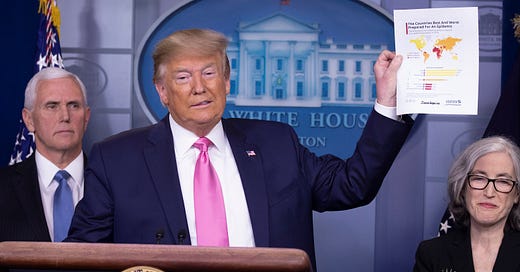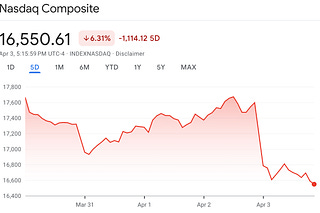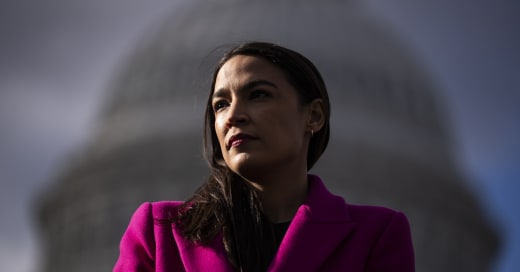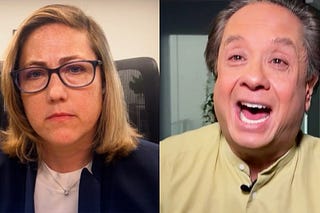
The Political Stakes of the Coronavirus Crisis
The Trump record so far gives plenty of reason to worry about what might come next.

President Donald Trump addressed the nation on the subject of the coronavirus on Wednesday night—after a week in which markets plunged, infections continued to spread, and fear, rumor, and conspiracy theories ran rampant.
“We’re very, very ready for this,” the president said, “whether it is going to be a breakout of larger proportions or whether or not we’re at [a] very low level.” The government is drawing on the “greatest experts in the world” to prepare for whatever comes next, he said, announcing that Vice President Mike Pence will take charge of coordinating federal response efforts with those of state and local governments.
The president’s remarks from the White House were an improvement over his previous —sparse—public comments about the coronavirus crisis. He has been uncharacteristically Panglossian in recent weeks, speculating that the coronavirus will go away with the warm weather and tweeting as recently as Monday that “CDC & World Health have been working hard and very smart” and “Stock Market starting to look very good to me” (after the Dow had tanked more than a thousand points that day).
Later in the week he ventured that “the whole situation will start working out” and claimed, implausibly, that “we’re very close” to having a vaccine. (Trump has never been especially sensible about vaccines.)
It’s increasingly clear that we’re facing a pandemic, and not only are we not “very close” to a vaccine (it’s likely a year or more away), not even experts know yet how to assess how hard the illness will hit, or whom, or when.
Considering the potential consequences of the coronavirus outbreak, which could become the first major international crisis of the Trump presidency, it bears reviewing what the government has done to prepare—and what remains to be done.
The federal government’s preparations began reasonably enough. On January 30—the same day the World Health Organization declared a global health emergency, and a week after the first confirmed coronavirus case in the United States—the Trump administration announced the creation of a coronavirus task force, led by Alex Azar, the secretary of health and human services. The U.S. public health effort was at first aimed at containment, or keeping the virus out of the country via screening at points of entry, isolation of those who tested positive, and quarantine of the exposed. But containment is a delicate tightrope to walk, and the time can come—quite suddenly, too—that some cosmic Terry Gilliam knocks your balancing act right into the void, and you’d better be hoping you have a net.
The United States does have a net, though its condition remains to be seen. As incidence of infection has spread around the world, the Department of Health and Human Services (HHS), the Centers for Disease Control and Prevention (CDC), the National Institutes of Health, and several other government bodies appear to have proceeded with dispatch to implement testing and begin development of vaccines and therapeutic protocols for people who catch the virus.
There have been some prominent missteps, though. When Americans quarantined on the floating Petri dish Diamond Princess were being flown home on February 15, there was bureaucratic confusion and disagreement over whether some who tested positive at the last minute should travel; the State Department overruled the CDC and included them. President Trump was reported to have been angry that the decision could affect both public safety and perceptions of administration response to the situation. He is said to have felt strongly about preventing the entry of infected people—that is, to have favored containment and prevention, which is a reasonable position. (It is certainly in keeping with the thrust of his tweeting about the Ebola crisis in 2014.)
Money talks: So far, the chief criticisms of the Trump administration’s actions, especially from the Democratic presidential candidates, have related to funding. This week’s White House request for $2.5 billion in emergency funding was greeted with skepticism by those who know that the president’s proposed budget for the CDC, released earlier this month, included a 13 percent cut to the category that includes “emerging and zoonotic infectious diseases,” of which COVID-19 is emphatically one. Even more drastically, previous Trump cuts knocked out whole networks of disease-outbreak oversight in the National Security Council and the Department of Homeland Security. For example, there is, as congressional Democrats have pointed out, no longer a global health security expert on Trump’s National Security Council staff. Suggestions that some funding be diverted to coronavirus programs from other health programs—such as programs intended to fight Ebola—were also unpopular in the House.
Reasonable people can of course disagree about the best use of resources for public-health purposes. It’s much harder to come up with an adequate explanation for the Trump administration’s anemic communication about COVID-19 for the last month. The task force has issued regular updates and held several carefully targeted briefings, which could be characterized as either prudent or anodyne. (Secretary Azar has been especially solicitous—personally prudent, one might say—about giving the president credit.) Otherwise there’s been little indication of urgency or attention at the highest levels of government.
Other administration efforts have ranged from tone deaf to distressingly clueless. Early on, Commerce Secretary Wilbur Ross undermined a statement of sympathy for the stricken Chinese by musing on live TV that the situation might “accelerate the return of jobs to North America.” And this past Monday, Acting Deputy HHS Secretary Ken Cuccinelli, a member of the task force, drew widespread ridicule for asking the Twittersphere to help him figure out how to access some coronavirus info on a Johns Hopkins website.
Meanwhile, a crisis of this nature would seem to demand the dissemination of reliable information—but you wouldn’t know it from watching the irresponsible rhetoric of some of the president’s allies. Republican senator Tom Cotton of Arkansas has repeatedly speculated in public that the virus may have escaped from a Chinese research lab, acknowledging when pressed that there’s no evidence (as scientists have said repeatedly) but ducking out with: “we need to at least ask the question.” Cuccinelli, too, chimed in as late as February 24—the same day as his risible Twitter search—that “people worry about” a “biological facility in the . . . province.” He conceded that experts think the virus is unlikely to be manmade, but then backtracked: “Does that mean it rules it out? No, not absolutely.”
There’s good news of a sort. In a Gallup poll conducted in the first half of February, 77 percent of the respondents (weighted to match national demographics) said they were “somewhat” or “very” confident the government would be able to handle a coronavirus outbreak. In a slightly earlier Morning Consult poll (also demographically weighted), 68 percent of the respondents said they were “somewhat” or “very” confident the CDC would be able to control the spread of the coronavirus; they had much less faith in the president, Congress, the airlines, and other entities.
Earlier this week, officials from the CDC and the coronavirus task force announced plans to deal with the expected “community spread” of COVID-19—that is, the appearance of cases of the disease among people with no history of travel to outbreak locations or contact with persons known to be infected. Anticipating such cases, the CDC’s Dr. Nancy Messonnier outlined examples of practical planning from the already well known (Wash your hands. No, better than that: Stay home if you’re sick.) to guidelines including school closures and telecommuting, to community-health directives to be called into play during a severe outbreak. On Wednesday night, shortly after President Trump’s press conference, the CDC confirmed the first apparent community-spread case in the United States.
One critical lesson from past global disease outbreaks: Clear, correct information is a necessity. Policymakers at every level of government need it. Business leaders need it, too. And so does the general public. The wide availability of trustworthy information makes prudent preparations possible and can help minimize bad decision-making in the thick of a crisis.
Rather than foolishly assuring people that everything will be a cakewalk, it is better to offer, without drama or exaggeration, the best estimates of potentially difficult scenarios, even quite bad ones. And the information should change as circumstances change. There’s a great deal that’s not yet known about (for example) the clinical picture of this virus, which means that information shared in good faith by the scientific community may have to be emended or even retracted at some point. Unnecessary vagueness (which is different from saying “we don’t know” when we don’t), blue-sky platitudes, or outright lying will destroy the credibility that may be as indispensable as saline solution in epidemic conditions.
It’s not just the medical authorities that people need to trust, though. Putting Vice President Pence at the head of the federal effort even more clearly identifies the Trump administration, for good or ill, with the management and outcome of the coronavirus episode in the United States. This will not be, as President Trump is all but certain to point out, fair.
The timing of this outbreak is problematic in another way: It comes at a time when—thanks in no small part to the president—there is widespread distrust in the disseminators of news and information. And it comes at a time when we’re really fed up with each other. If our leaders insist on lying to prevent panic, the effect of even minor setbacks will likely be to worsen the widespread rejection of authority at the worst possible time.









